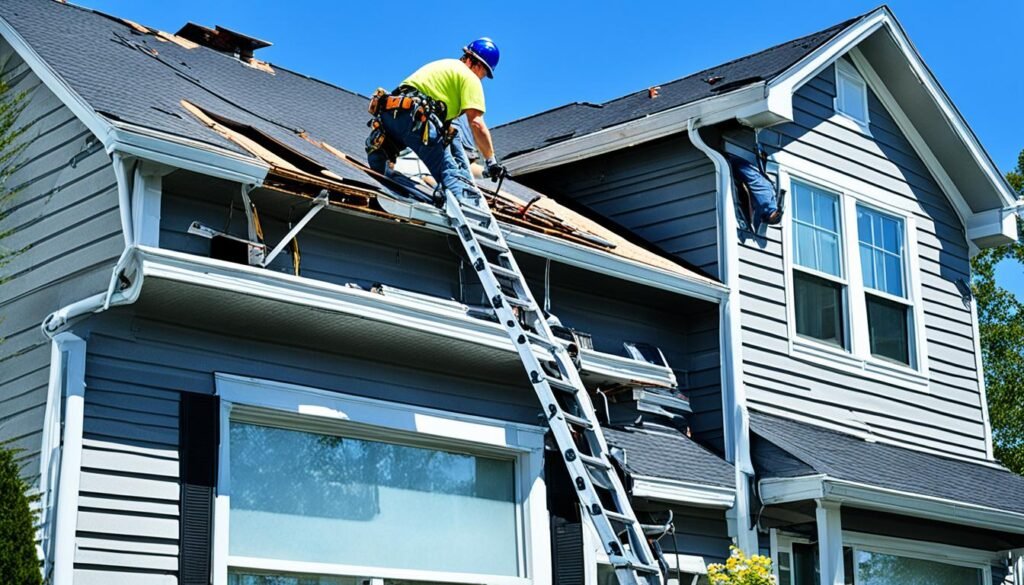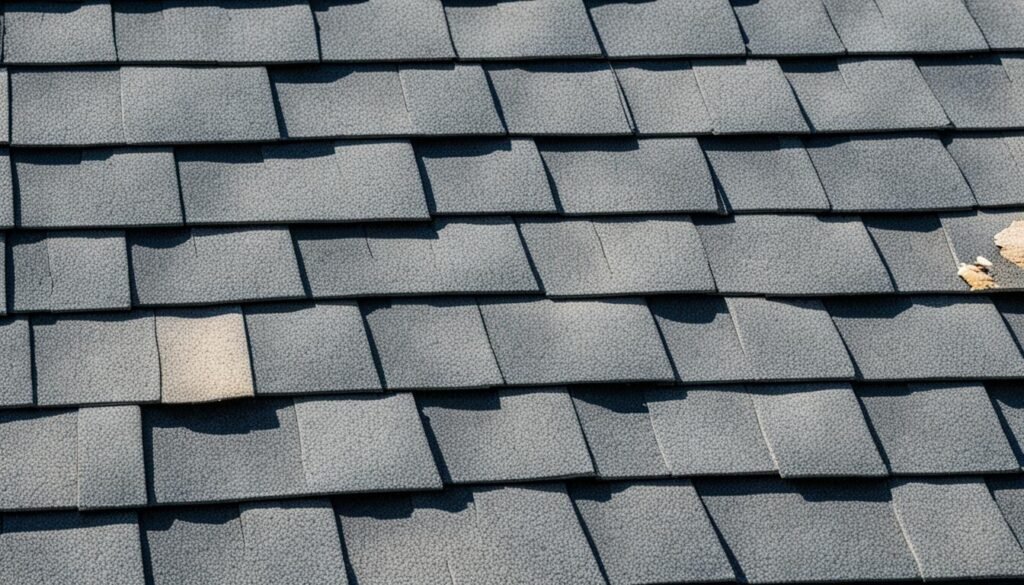Neglected or unrepaired roofs can cause big issues like leaks, mold, and roof collapse. Shockingly, 1 in 4 homes in the U.S. has some roof trouble. This means quick checks and fixes are super important for all property owners.
Checking for and fixing roof damage is key for safety and keeping your place strong. It’s not something you should ignore. You need to look closely for water stains, mold, mildew, and leaks. These signs show something might be very wrong with your roof.
Key Takeaways:
- Regular inspections can detect potential problems early, preventing more costly issues.
- Leaks must be identified promptly to maintain the structural integrity of the roof.
- Water stains, mold, and damaged shingles are indicators of roof damage that should be addressed.
- The attic is a common place where hidden roof problems can be revealed.
- Proper sealing and maintenance are crucial for the longevity of residential and commercial roofs.
Recognizing Signs of Structural Roof Damage
Finding roof damage early can help you avoid big problems and costs later. Check your attic and outside often. This can keep your roof in good shape and save you money.
Interior Signs of Damage
Start by looking in your attic. You might see water damage or mold first. Also, watch out for wet insulation and water spots on the roof. Smells and peeling paint inside can mean your roof is leaking. Look at your ceilings. If they’re sagging, your roof’s frame might have problems.
Exterior Signs of Damage
From outside, check for missing or damaged shingles. Look closely at the areas around chimneys and vents. If the flashing is bad, water can get in. Also, make sure your roof nails and gutters are in good shape. They protect your roof from the weather.
Finding problems early stops structural roof damage and more. If you think something is wrong, call a roofer. They can fix the issue quickly. This protects your home from many dangers, like hail strike damage.

“Catching roof damage early can save you thousands in the long run. Don’t wait until it’s too late to address the problem.”
Assessing and Addressing Structural roof damage
Keeping your roof strong is vital for safety and your place’s life. After bad weather or just regular wear, dealing with roof issues quickly is a must. This ensures your roof stays tough, saving your home from more damage.
To start fixing your roof, clear out everything. This means move any debris, tools, or furniture that could get in the way or be dangerous. Then, look at your roof to see how bad the damage is and what’s needed to fix it.
Stop more water damage before you start making repairs. Cover damaged parts with tarps to keep water out. This step is key in preventing further problems.
Using top-notch materials for repairs is crucial. New roof parts, like trusses or rafters, may be needed, depending on the damage. After fixing it, make sure everything is well sealed to keep water out and the roof strong.
Fixing roof damage needs a careful plan. By working through these steps, you can make your roof as good as new, keeping your property and those inside safe. If you’re not sure what to do, talking to a roofing expert is always a smart move.
| Importance of Assessing Structural Damage | Types of Structural Damage to Look For |
|---|---|
|
|
Fixing your roof fast is essential for property and people’s safety. Prevention is the best plan, so often check your roof and keep it well-maintained to avoid big issues.

Conclusion
This article explored different types of roof damage. These include structural roof damage and attic ventilation issues. Also, it discussed shingle deterioration, flashing leaks, rafter sagging, and more. We learned how to identify and fix these issues to keep our homes safe and valuable.
It’s important to inspect your roof often with the help of professionals. The team at Local Roofer Pros can help with this. They can make sure your roof lasts long and your home stays safe. If you need expert advice, reach out to Local Roofer Pros for a free estimate. This approach will save you from worry and your home from danger.
Know the warning signs and act early to protect your home. Keeping your roof strong is key to maintaining your home’s worth. With the right information and help from experts, your roof can stay in great shape for a long time.
FAQ
What are the common signs of structural roof damage?
How can I inspect my roof for potential problems?
What should I do if I find signs of roof damage?
How can I prevent future roof damage?
Where can I find a reliable roofer to handle my roof repair needs?
Source Links
- https://roofingbylandmark.com/assessing-repairing-roof-damage/
- https://www.ableroof.com/blog/recognizing-roof-damage-types/
- https://newviewroofing.com/blog/roof-damage/roof-structure-repair-what-you-need-to-know/
- https://www.mhhroofing.com/2024/05/06/recognizing-the-signs-of-roof-damage-a-practical-guide-for-homeowners/
- https://apexroofs.com/signs-of-roof-damage/
- https://duvalroofing.com/9-signs-of-roof-damage-that-you-shouldnt-ignore/
- https://www.unitedffs.com/assessing-structural-damage-of-a-property/
- https://www.insuranceclaimrecoverysupport.com/building-damage/
- https://britetoproofing.com/top-5-steps-to-take-if-your-roof-is-damaged/
- https://www.mightydogroofing.com/blog/categories/repairs/common-types-of-roof-damage/
- https://vantageroofingltd.ca/12-common-threats-to-your-roofs-structural-integrity/
- https://buckheadroofing.com/identifying-the-various-types-of-roof-damage-a-comprehensive-guide-for-homeowners/
- Local Roofer Pros
